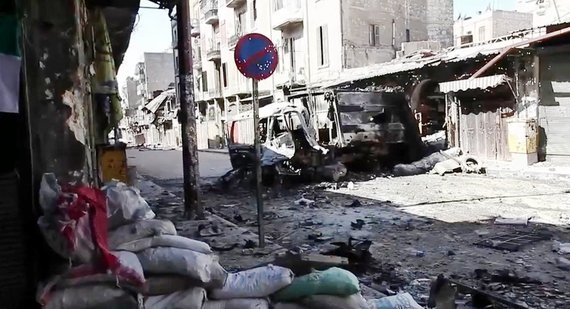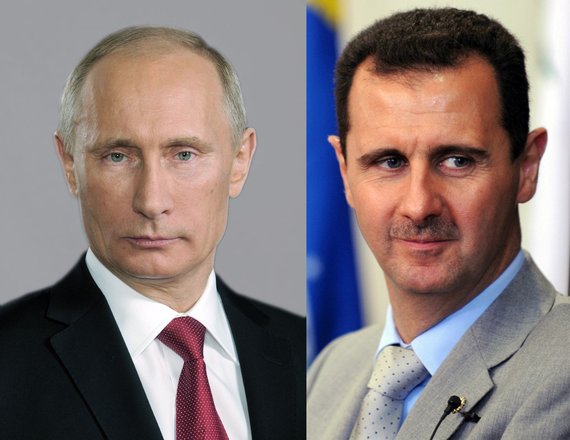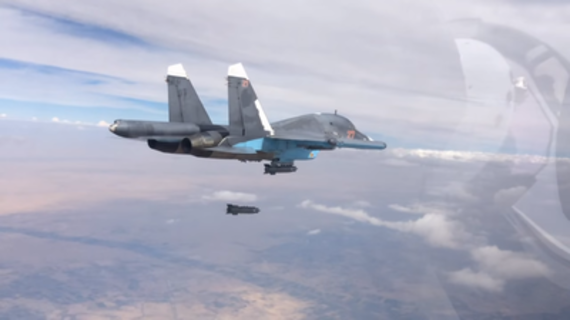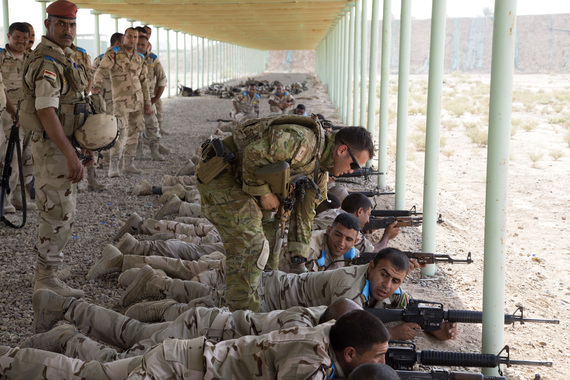As the crow flies Aleppo and Mosul are little more than 300 miles apart. They mark, roughly, the western and eastern edges of the Islamic State. Both cities are presently the scenes of important battles for control that will help determine the future of the Islamic State, and by extension, the current Syrian and Iraqi governments; and currently, both battles are going badly for Washington and its allies.
Aleppo is the second largest city in Syria. For the last four years it has been contested by the Free Syrian Army, various Jihadist groups, including the al-Qaeda affiliated al-Nusrah Front, and the Assad government. At one point during the summer of 2015, it seemed that the Free Syrian Army was on the verge of taking control of the city and expelling the pro-Assad Syrian Army and its militias. The loss of Aleppo would have been a significant setback for the Assad government. It might well have marked the beginning of the end for the Assad dynasty in Syria.
Some nine months later, following the intervention of Russian military forces in support of the Syrian government, the situation is sharply reversed. It is the Free Syrian Army that now finds itself largely surrounded and, its recent successes notwithstanding, in danger of collapsing. Its lifeline to Turkey is almost entirely closed off, while Syrian troops, supported by Russian air power and Russian Special Forces units, are steadily drawing a noose around Aleppo's beleaguered defenders.
In the meantime, the Obama Administration continues to play out the farce that it is engaging with Russia to organize a ceasefire and craft a political solution to end the Syrian Civil War. The Syrian ceasefire is failing because neither Damascus nor Moscow has any interest in maintaining it or in crafting a political solution to end the fighting in Syria.
Indeed, the Kremlin has already made it clear what it considers an acceptable political solution: the continuation of the Assad government, an unspecified role for the "moderate" Syrian rebels in an Assad administration and a combined Russian-American effort to eradicate Islamic State and other radical jihadist groups. To his credit Vladimir Putin is well on his way to accomplishing exactly what he said he was going to do. A lesson that is not lost on Russia's allies in the Middle East nor on America's.
The Syrian government always had the advantage when it came to air power. Modest as its air forces were, they was still more than those possessed by the Free Syrian Army. They had none to speak of. Russian air power, however, tipped the balance of military power decisively in favor of the Assad government. After a rocky start, the combination of Syrian ground troops and Russian air forces have proven to be an effective and lethal combination. In Aleppo they have steadily worn down the Free Syrian Army and its Islamist allies. At this point, barring a dramatic change in battlefield conditions, it is only a question of time until Assad's troops prevail in the Battle of Aleppo.
Washington had an opportunity to declare a no-fly zone over the Syrian battlefield prior to Russia's intervention. Syrian rebel groups were asking for a no-fly zone as early as 2011. In February 2014, UN Security Council Resolution 2139 demanded an end to attacks on civilians and called for "further steps in the case of non-compliance." This was widely interpreted as a call for a no fly zone. The Obama Administration, however, demurred. A no-fly zone at this point would have shifted the military balance in favor of the Syrian rebels.
Following the Russian intervention, the Obama White House was quick to declare that "it would not cooperate" with Moscow's aims and that the Kremlin's actions would lead Russia into a "quagmire" and further aggravate the crisis in the Middle East. The Obama Administration continued to insist that a resolution of the Syrian Civil War would require the departure of Bashar al-Assad. At the same time, however, the White House made it clear that it would not challenge Russian air power over Syria, and while it would continue to supply arms to the Free Syrian Army, it would not attack the Syrian Army or defend the Free Syrian Army from Russian attacks.
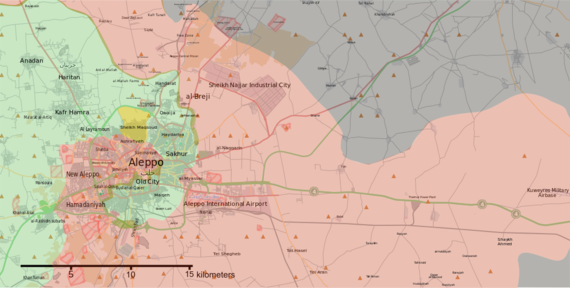 Disposition of Syrian rebel and Syrian Army forces in Aleppo, Spring 2016. Pink: Syrian Army Froces, Green: Syrian Rebels, Grey: Islamic State.
Disposition of Syrian rebel and Syrian Army forces in Aleppo, Spring 2016. Pink: Syrian Army Froces, Green: Syrian Rebels, Grey: Islamic State.
The outcome was predictable. Bolstered by Russian air power, the Assad government steadily tipped the military balance in its favor. It was clear by the winter of 2015, that in the absence of any concerted US action, only a Turkish ground invasion would save the Free Syrian Army in Aleppo from being surrounded and overrun. A Turkish ground invasion, however, would have required American air cover to be successful. After toying with the idea the Obama administration opted not to participate.
Instead the White House agreed to the Russian proposal for a ceasefire. A ceasefire that was little more than a façade to forestall a Turkish intervention and to give political cover to Washington and save it from the embarrassment of having a bankrupt policy clearly exposed. While the ceasefire may have diminished, somewhat, the intensity of the fighting in Syria, it did little to stop the fighting for Aleppo. Instead, whenever world opinion reaches a crescendo, Russia, aided by the United States, trots out the prospect of a new ceasefire until the outrage over the carnage in Syria diminishes sufficiently for Moscow and Damascus to return to business as usual.
The Kremlin is not yet ready to declare victory in the Syrian Civil War, but it has made considerable progress in redefining the political landscape in Syria. It is now inconceivable that there is any scenario in the future of Syria that will not include the continued involvement of Bashar al-Assad. For the United States and its allies the choice is increasingly one between accepting the continuation of the Assad regime, albeit possibly with some participation of the Syrian rebels, or aligning itself with radical jihadist elements to overthrow Assad. Given that those jihadist groups include organizations that are mortal enemies of the United Stated, it's clear there is little choice.
Three hundred miles away, another battle is gearing up. This one for Mosul, once the second largest city in Iraq, with a population of around two million people. Today it is around a quarter of that. The city has been largely surrounded, with all of the major roads, except for Highway 1 to Baji, blocked. Iraqi troops and Shiite militias have been advancing from the south, while Peshmerga forces have held defensive positions to the north, east and west of the city.
As of May 22, Iraqi troops were contesting the village of Al Qayyarah, about 22 miles south of Mosul and about 5 miles east of the junction with Highway 1. Al Qayyarah also hosts a former Iraqi Air Force base (Saddam Air Base), about 15 miles due west of the town. The air base, now known as Qayyarah West Airfield, is a major facility. Its runways can accommodate a C-5 Galaxy, and the air base can serve as a major supply point during the upcoming battle for Mosul.
The US has quietly built up its deployment in the area in support of the Iraqi offensive. It's unclear what the total American ground presence in Iraq is, but it is certainly higher than the authorized limit of 3,870, the official estimate previously circulated by the Pentagon. The actual number of US troops on the ground is estimated at between 4,000 and 5,000. In addition, notwithstanding the Obama White House's insistence that the American troops are in Iraq in an advisory and training role, Marine General Joseph Dunford, Chairman of the Joint Chiefs of Staff, has confirmed in Congressional testimony that US troops are actively involved in combat roles.
US Special Forces are involved in training and advising their Iraqi counterparts, and they are also carrying out their own missions independent of the Iraqi military. In addition the US has established a fire base (Fire Base Bell/Kara Soar Counter Fire Complex) near Makhmour to provide artillery support for Iraqi troops. The fire base hosts four 155 mm howitzers and is manned by approximately 200 Marines from the 26th Marine Expeditionary Unit. The Pentagon has indicated that it is open to establishing more fire bases in northern Iraq as needed. The Marines at Fire Base Bell are soon going to be replaced by members of the 101st Airborne from Fort Campbell, Kentucky.
Despite the appearance of steady progress, privately US military officials have expressed serious misgivings about the upcoming battle for Mosul. What role the Shiite militias will play has not been settled. The US has been adamant that Shia militias would not be involved in the liberation of Mosul. The radical Shiite leader Muqtada al-Sadr, widely seen as an Iranian proxy in Iraq, has, on the other hand, demanded a role for his official militia, the Saraya al-Salam (Peace Brigades).
The Peace Brigades are a part of a broader grouping of Shia militias known as the Popular Mobilization Unit, which was organized in June 2014, following the routing of the Iraqi Army by Islamic State militants. The group also includes the Hezbollah Brigades, Asaib al-Haq (Righteous League), Harakat Nujaba (Movement of the Noble), Saraya Khorasan (Khorasan Brigades) and the Iman Ali Brigades. All of these groups are hostile to the US and have received arms, financing and training by Iranian Revolutionary Guards. The Hezbollah Brigades are classified as a Foreign Terrorist Organization by the US State Department and many of the leaders of the other militias are listed as foreign terrorists.
On April 30, thousands of supporters of al-Sadr burst into the heavily defended, supposedly impenetrable, Green Zone, and occupied the Iraqi Parliament, as well as a number of other government buildings. The protest was triggered by al-Sadr's repeated calls to end the endemic corruption in the Iraqi government, hold early elections and improve the delivery of government social services to Iraqis. Al-Sadr has also been demanding an end to the political quota system originally set up by the US. The abolishment of the quota system would further marginalize Iraq's Sunni and Kurdish populations.
On May 20, al-Sadr supporters again invaded the Green Zone, the latest incident in what is now a recurring pattern of weekly Friday protests against the Baghdad government. This time they were dispersed by tear gas before they could occupy any buildings.
Initially, the occupation of the Iraqi Parliament by al-Sadr's supporters was seen as a potential coup attempt. Those fears were abated when the protestors peacefully disbanded the next day. Although the protestors did not specifically cite the role of the Shia militias in the liberation of Mosul, the lesson was not lost on the government of Prime Minister Haider al-Abadi.
Muqtada al-Sadr is rapidly emerging as the de facto king maker in Baghdad. Attempts to exclude the Shia militias from the upcoming battle for Mosul will simply add to the instability and deadlock that is already gripping the Baghdad government.
How the combination of Iraqi military, Shia militias and Kurdish Peshmerga forces will collaborate remains to be seen. The initial plan floated by US military officials was for Peshmerga forces to assume defensive roles to the north, east and west of Mosul and control the major roads from the city, while Iraqi military forces advanced from the south.
The Shiite militias are wild cards that will complicate this strategy. They will not take direction from US military officials nor does the US want to use them. Under the direction of their Iranian Revolutionary Guard advisors, they may execute their own battle strategy; one that may well put them at odds with the American-led effort. Already there have been a number of clashes between Kurdish troops and Shia militias in the area.
The Battle for Mosul will require both a military plan and a political one. Without a political consensus on who will fight the battle, what role each party will play and most importantly what the post-ISIS disposition of Mosul is going to be, any military strategy risks falling apart to political feuding. Moreover, the political solution regarding the Battle for Mosul risks becoming an additional factor destabilizing the Baghdad government. Militarily, the battle for Mosul can be won without having a political solution in place, but it will make fighting such a battle harder, longer and far more complicated than it would otherwise be.
Finally, there is the issue of the Iraqi Army's battlefield performance. To date, to put it charitably, it has been mixed. Some elements of the Iraqi Army, especially the US trained Special Forces have performed well. Other units have not. On March 19, for example, Marine Sargent Louis Cardin, 27, was killed and eight other Marines were injured at Fire Base Bell by Islamic State mortar attacks. The IS militants were able to advance within range of the fire base when the Iraqi troops defending the base abandoned their positions in response to attacks by Islamic State forces.
The current US effort in support of Iraqi forces is much more substantial and much more focused than previous efforts. In addition to the US troops on the ground and the artillery support at Fire Base Bell, it appears that the US has imbedded forward air controllers with Peshmerga and Iraqi units to better coordinate air support. It still falls on the Iraqi Army, however, to fight Islamic State militants for the eventual control of Mosul. The question of whether the Iraqi military is up to that fight remains unanswered, as does the issue of whether a political consensus on how the battle for Mosul will be fought can be reached.
Two cities, two battles--the one for Aleppo now entering a decisive phase, while the one for Mosul is just beginning. In Aleppo, a US ally is being decimated while Washington, having ceded the initiative in Syria to Moscow, stands by. In Mosul the absence of a political consensus means the battle will be long, difficult and far more complicated than it needs to be.
The Obama Administration wants to project the image that it has a sophisticated, nuanced view of events in the Middle East, a view tempered by history and part of a well thought out, long-term plan to disengage the US from the region while bringing it the stability of a balance of power among the various nations there. Criticism of the Administration is dismissed by President Obama as "mumbo jumbo," and his critics as would be hawks with a hopelessly naïve view of Middle East realities.
The fact is that the inability and the unwillingness of the Obama White House to act to reduce the violence tearing the region apart has created a far bigger crisis and a far greater humanitarian toll, one that will ultimately have far graver consequences for the US and its allies. A faster, more focused response, like a no-fly zone over Syria back in 2014, or a more determined effort to crush Islamic State, especially to destroy its financial resources, would have contained the crisis and the violence it is spewing far better.
Instead, the Administration's policy in Syria and Iraq has consistently been one of hesitancy and indecision. Washington is finally getting around to crafting a more effective response and, while more successful, it is generally one of too little, too late. This is not an Administration with a long view of Middle East realities, this is not a White House with a nuanced and sophisticated view of Middle East affairs. This is a government that has demonstrated by it policies to be, frankly, clueless.

